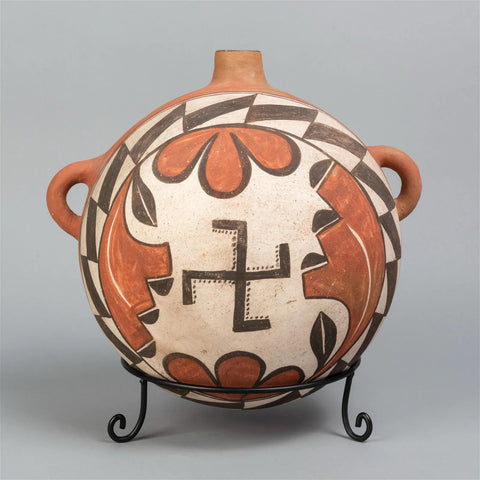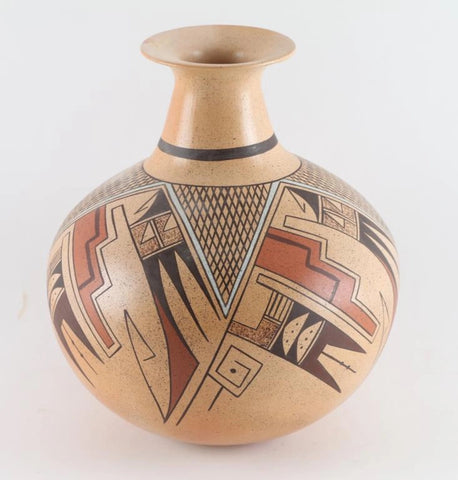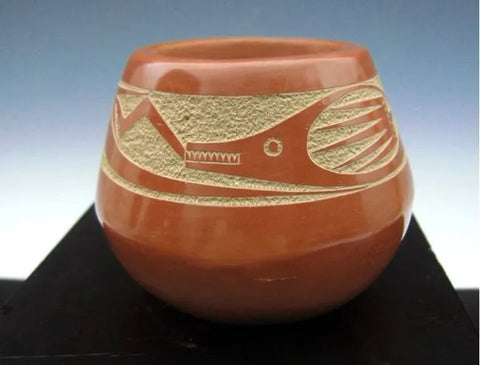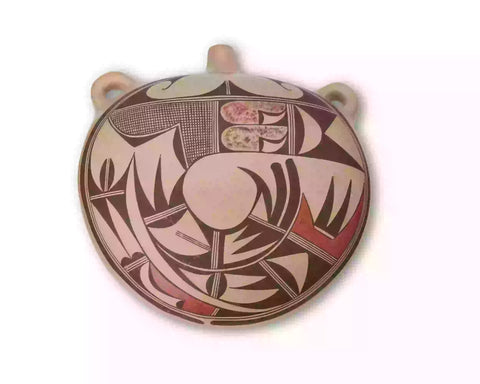
Native American, Historic Hopi Poly Chrome Pottery Bowl, by Elva Nampeyo, Ca 1950's-1960's, #1133
$ 1,200.00
Native American,
Historic Hopi Poly Chrome Pottery Bowl,
by Elva Nampeyo, Ca 1950's-1960's, #1133
Description: #1133 Native American, Historic Hopi Poly Chrome Pottery Bowl, by Elva Nampeyo, Ca 1950's-1960's, Hopi bowl signed Elva Nampeyo (Hopi-Tewa Corn Clan, First Mesa, Hopi Reservation, Arizona, 1926-1985),
Dimensions: 3"h, 7" diameter,
Condition: Overall in very good condition.
Some background on Elva Nampeyo:
Elva Nampeyo (1926–1985) (also known as Elva Tewaguna) was an American studio potter. She was born in the Corn Clan house where her grandmother Nampeyo resided, atop Hopi First Mesa. She was the daughter of Fannie Nampeyo and Vinton Polacca. As a child Elva would watch her grandmother make pottery and play with the clay. When she was eleven years old her mother began teaching her to make pottery.
Elva became an expert at decorating and painting pottery. Her husband, Richard Tewaguna, never became involved in her pottery making. She specialized in black and red on yellow bowls and jars with traditional migration designs and eagle motifs. Her pieces most often resembled the works of her mother and grandmother. On occasion she could be persuaded to break from tradition and try some designs of her own invention. Elva took great pleasure in making pottery and could form as many as eight pots a day. During her later years when she was no longer able to finish her work, her daughter Adelle would polish, decorate and fire the pottery for her. Elva signed her pottery as "Elva Nampeyo" followed by the corn clan symbol which was initiated by her mother Fannie. Elva had five children of which four are potters including Neva, Elton, Miriam and Adelle. All sign their work with their first names followed by "Nampeyo" and an ear of corn. She died in 1985.
References
Blair, Mary Ellen; Blair, Laurence R. (1999). The Legacy of a Master Potter: Nampeyo and Her Descendants. Tucson: Treasure Chest Books. ISBN 1887896066. OCLC 41666705.
Schaaf, Gregory - Hopi-Tewa Pottery: 500 Artist Biographies. 1998.
External links Biography portal
Elva Nampeyo at the Holmes Museum of Anthropology
"Elva Nampeyo Pottery" search at Google Images
(Source: Wikipedia)
“Pueblo pottery is made using a coiled technique that came into northern Arizona and New Mexico from the south, some 1500 years ago. In the four-corners region of the US, nineteen pueblos and villages have historically produced pottery. Although each of these pueblos use similar traditional methods of coiling, shaping, finishing and firing, the pottery from each is distinctive. Various clay's gathered from each pueblo’s local sources produce pottery colors that range from buff to earthy yellows, oranges, and reds, as well as black. Fired pots are sometimes left plain and other times decorated—most frequently with paint and occasionally with applique. Painted designs vary from pueblo to pueblo, yet share an ancient iconography based on abstract representations of clouds, rain, feathers, birds, plants, animals and other natural world features.
Tempering materials and paints, also from natural sources, contribute further to the distinctiveness of each pueblo’s pottery. Some paints are derived from plants, others from minerals. Before firing, potters in some pueblos apply a light colored slip to their pottery, which creates a bright background for painted designs or simply a lighter color plain ware vessel. Designs are painted on before firing, traditionally with a brush fashioned Designs are painted on before firing, traditionally with a brush fashioned from yucca fiber.
Different combinations of paint color, clay color, and slips are characteristic of different pueblos. Among them are black on cream, black on buff, black on red, dark brown and dark red on white (as found in Zuni pottery), matte red on red, and poly'chrome—a number of natural colors on one vessel (most typically associated with Hopi). Pueblo potters also produce un'decorated polished black ware, black on black ware, and carved red and carved black wares.
Making pueblo pottery is a time-consuming effort that includes gathering and preparing the clay, building and shaping the coiled pot, gathering plants to make the colored dyes, constructing yucca brushes, and, often, making a clay slip. While some Pueblo artists fire in kilns, most still fire in the traditional way in an outside fire pit, covering their vessels with large potsherds and dried sheep dung. Pottery is left to bake for many hours, producing a high-fired result.
Today, Pueblo potters continue to honor this centuries-old tradition of hand-coiled pottery production, yet value the need for contemporary artistic expression as well. They continue to improve their style, methods and designs, often combining traditional and contemporary techniques to create striking new works of art.” (Source: Museum of Northern Arizona)
Historic Hopi Poly Chrome Pottery Bowl,
by Elva Nampeyo, Ca 1950's-1960's, #1133
Description: #1133 Native American, Historic Hopi Poly Chrome Pottery Bowl, by Elva Nampeyo, Ca 1950's-1960's, Hopi bowl signed Elva Nampeyo (Hopi-Tewa Corn Clan, First Mesa, Hopi Reservation, Arizona, 1926-1985),
Dimensions: 3"h, 7" diameter,
Condition: Overall in very good condition.
Some background on Elva Nampeyo:
Elva Nampeyo (1926–1985) (also known as Elva Tewaguna) was an American studio potter. She was born in the Corn Clan house where her grandmother Nampeyo resided, atop Hopi First Mesa. She was the daughter of Fannie Nampeyo and Vinton Polacca. As a child Elva would watch her grandmother make pottery and play with the clay. When she was eleven years old her mother began teaching her to make pottery.
Elva became an expert at decorating and painting pottery. Her husband, Richard Tewaguna, never became involved in her pottery making. She specialized in black and red on yellow bowls and jars with traditional migration designs and eagle motifs. Her pieces most often resembled the works of her mother and grandmother. On occasion she could be persuaded to break from tradition and try some designs of her own invention. Elva took great pleasure in making pottery and could form as many as eight pots a day. During her later years when she was no longer able to finish her work, her daughter Adelle would polish, decorate and fire the pottery for her. Elva signed her pottery as "Elva Nampeyo" followed by the corn clan symbol which was initiated by her mother Fannie. Elva had five children of which four are potters including Neva, Elton, Miriam and Adelle. All sign their work with their first names followed by "Nampeyo" and an ear of corn. She died in 1985.
References
Blair, Mary Ellen; Blair, Laurence R. (1999). The Legacy of a Master Potter: Nampeyo and Her Descendants. Tucson: Treasure Chest Books. ISBN 1887896066. OCLC 41666705.
Schaaf, Gregory - Hopi-Tewa Pottery: 500 Artist Biographies. 1998.
External links Biography portal
Elva Nampeyo at the Holmes Museum of Anthropology
"Elva Nampeyo Pottery" search at Google Images
(Source: Wikipedia)
“Pueblo pottery is made using a coiled technique that came into northern Arizona and New Mexico from the south, some 1500 years ago. In the four-corners region of the US, nineteen pueblos and villages have historically produced pottery. Although each of these pueblos use similar traditional methods of coiling, shaping, finishing and firing, the pottery from each is distinctive. Various clay's gathered from each pueblo’s local sources produce pottery colors that range from buff to earthy yellows, oranges, and reds, as well as black. Fired pots are sometimes left plain and other times decorated—most frequently with paint and occasionally with applique. Painted designs vary from pueblo to pueblo, yet share an ancient iconography based on abstract representations of clouds, rain, feathers, birds, plants, animals and other natural world features.
Tempering materials and paints, also from natural sources, contribute further to the distinctiveness of each pueblo’s pottery. Some paints are derived from plants, others from minerals. Before firing, potters in some pueblos apply a light colored slip to their pottery, which creates a bright background for painted designs or simply a lighter color plain ware vessel. Designs are painted on before firing, traditionally with a brush fashioned Designs are painted on before firing, traditionally with a brush fashioned from yucca fiber.
Different combinations of paint color, clay color, and slips are characteristic of different pueblos. Among them are black on cream, black on buff, black on red, dark brown and dark red on white (as found in Zuni pottery), matte red on red, and poly'chrome—a number of natural colors on one vessel (most typically associated with Hopi). Pueblo potters also produce un'decorated polished black ware, black on black ware, and carved red and carved black wares.
Making pueblo pottery is a time-consuming effort that includes gathering and preparing the clay, building and shaping the coiled pot, gathering plants to make the colored dyes, constructing yucca brushes, and, often, making a clay slip. While some Pueblo artists fire in kilns, most still fire in the traditional way in an outside fire pit, covering their vessels with large potsherds and dried sheep dung. Pottery is left to bake for many hours, producing a high-fired result.
Today, Pueblo potters continue to honor this centuries-old tradition of hand-coiled pottery production, yet value the need for contemporary artistic expression as well. They continue to improve their style, methods and designs, often combining traditional and contemporary techniques to create striking new works of art.” (Source: Museum of Northern Arizona)
Related Products
Sold out







